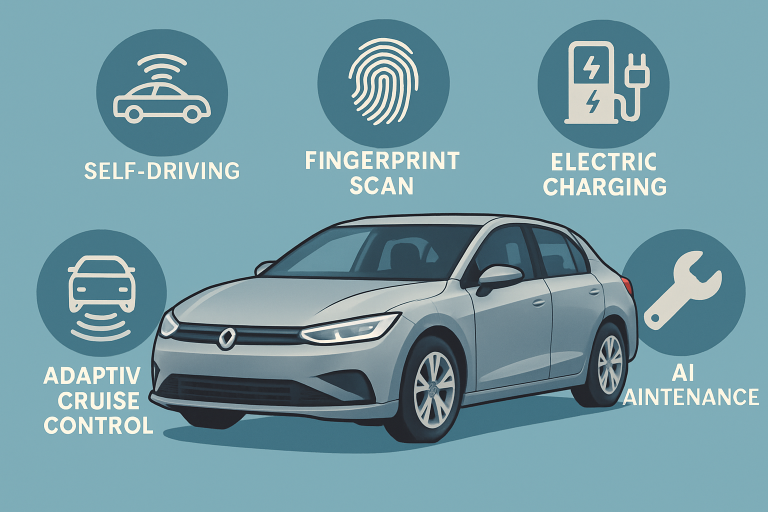Table of Contents
- Introduction
- Self-Driving Technology
- Biometric Car Keys
- Electric Vehicle Advancements
- Adaptive Technologies
- AI-Powered Predictive Maintenance
Introduction
The automotive industry is experiencing an unprecedented wave of technological innovation, resulting in cars that are safer, more convenient, and increasingly attuned to drivers' lifestyles. From self-driving systems to AI-powered maintenance, these advancements are not just futuristic concepts—they are shaping today’s driving experiences for the better. If you’re interested in exploring the latest models equipped with these transformative technologies, Learn more about the latest vehicles available now.
Consumers today expect their vehicles to offer a blend of protection, ease, and intelligence through seamless, integrated features. Automakers are responding by introducing functions that once seemed possible only in science fiction. This article delves into five key innovations redefining the driving landscape and making every journey smarter, safer, and more enjoyable.
Self-Driving Technology
Self-driving technology is possibly the most transformative development in the automotive sector, with companies like Waymo expanding autonomous ride-shares and pilot programs in several U.S. cities. These advancements rely on a combination of artificial intelligence and real-time sensor data to guide vehicles safely and efficiently. Leading car makers are racing to refine their driver-assistance systems—such as Tesla’s Autopilot and Ford’s BlueCruise—accumulating millions of miles of real-world testing.
These systems can oversee everything from adaptive cruise control to lane centering, significantly reducing the likelihood of human error and fostering peace of mind among drivers. As further research and breakthroughs in regulations evolve, it’s expected that self-driving technology will play a crucial role in drastically improving road safety for everyone. To follow industry developments and regulatory news, visit The Verge’s recent coverage on autonomous vehicle trends.
Biometric Car Keys
The shift from traditional keys to biometric systems is ushering in a new era of automotive security and convenience. Biometric car keys harness facial and fingerprint recognition, as seen in Hyundai’s Genesis GV60 and latest Tesla models, granting access and ignition with a simple scan. This technology not only mitigates the risk of theft but also personalizes the driving experience—settings such as seating, mirrors, and climate control automatically adjust to each driver’s profile upon entry.
Biometric authentication also cuts down on the hassle of lost or stolen keys, offering a seamless transition from door to dashboard, particularly beneficial for families and multiple car users. As manufacturers continue to integrate these advanced solutions, biometric technology is likely to become a new industry norm, focusing simultaneously on enhanced protection and user-friendly operation.
Electric Vehicle Advancements
The evolution of electric vehicles (EVs) is driving the transition toward cleaner and more efficient transportation options. One of the newest breakthroughs is the introduction of customizable battery range options, such as those in the 2026 Kia EV4. These batteries allow consumers to choose a range that fits their driving habits, reducing both anxiety and cost. Such adaptability enables automakers to cater to wider audiences—from daily commuters needing short-range batteries to travelers requiring extended ranges for road trips.
Additionally, improvements in battery performance, charging networks, and energy management are making EV ownership practical for more people than ever before. These trends, supported by government incentives and infrastructure investments, position electric vehicles as a pivotal component in achieving long-term sustainability goals.

Adaptive Technologies
Vehicles are now equipped with adaptive technologies that respond instantly to road conditions and driver commands. Subaru’s EyeSight Driver Assist suite, for example, brings features such as adaptive cruise control, lane-keeping, pre-collision braking, and throttle management to the mainstream. Meanwhile, AI voice assistants—like Kia’s partnership with SoundHound—ensure drivers can interact hands-free with navigation, entertainment, and vehicle settings, helping minimize distractions and enhance focus.
The proliferation of these features in even entry-level trims marks a shift toward democratized safety and luxury. By automating tasks and actively supporting the driver, these intelligent systems are not just conveniences but critical tools in reducing accidents and creating a more relaxing driving experience.
Future Trends: AI-Powered Predictive Maintenance
AI-driven predictive maintenance tools, like GM's OnStar platform, are revolutionizing vehicle maintenance by detecting wear signs before malfunctions occur. This results in smarter repair scheduling, less downtime, and significant savings on unexpected breakdowns. Real-time diagnostic capabilities also offer insights that would have required a mechanic visit, enabling remote updates and proactive service reminders. As manufacturers adopt AI for predictive maintenance, drivers can expect higher reliability and lower costs, enhancing the overall ownership experience. Modern vehicles showcase innovation, adding value and security to the time spent on the road. Staying informed about these advancements allows drivers to make empowered choices and fully benefit from the latest automotive technology.



No comments:
Post a Comment
I love reading and responding to comments but in order to get my reply you must ensure you are NOT a no-reply blogger. If you are, here are some quick steps to change that!
1. Go to the home page of your Blogger account.
2. Select the drop down beside your name on the top right corner and choose Blogger Profile.
3. Select Edit Profile at the top right.
4. Select the Show My Email Address box.
5. Hit Save Profile.